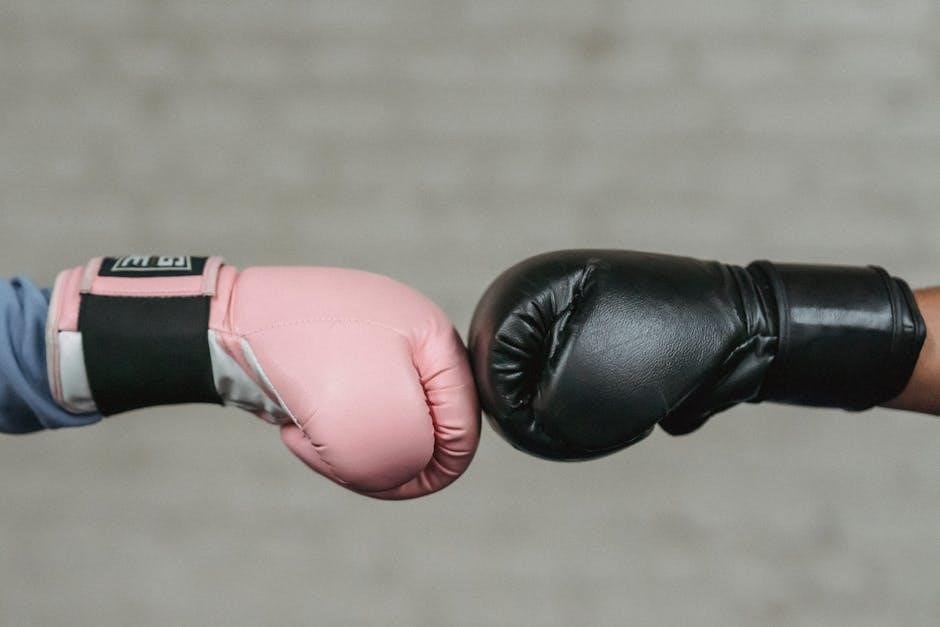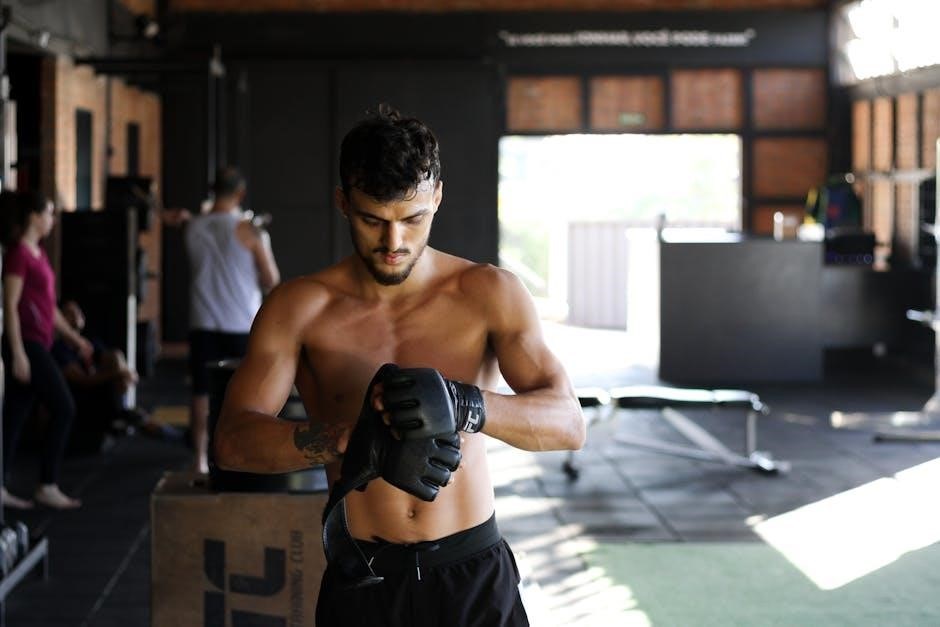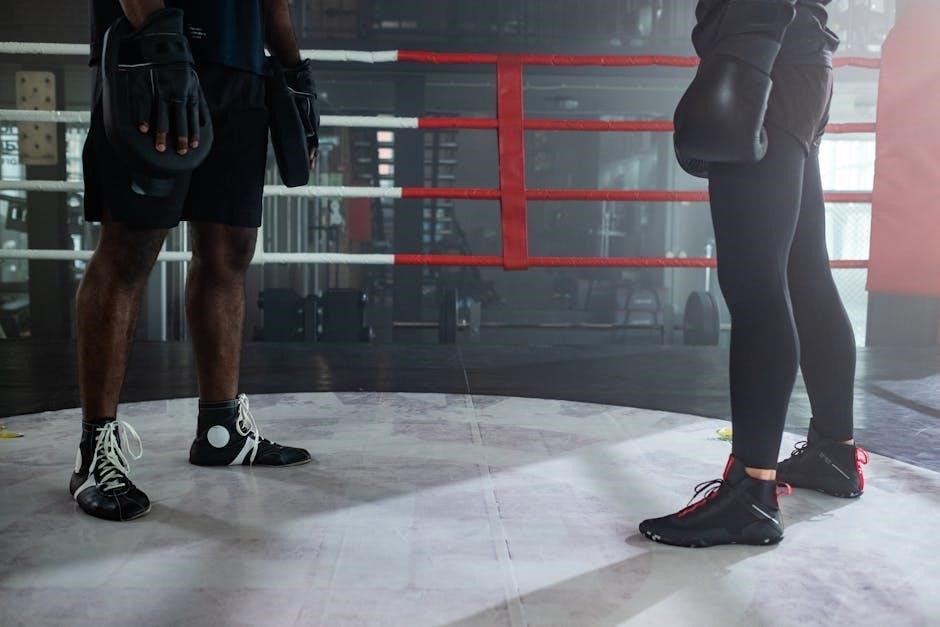boxing gloves sizes guide
Boxing gloves sizes guide: Proper fit ensures protection, comfort, and performance. Gloves vary by weight (6-18oz) and size (Small to 4XL), catering to different needs and preferences;
Importance of Choosing the Right Glove Size
Choosing the right boxing glove size is crucial for safety, performance, and comfort. Properly fitted gloves protect hands from injury, absorb impact, and improve technique. Ill-fitting gloves can lead to discomfort, reduced control, and increased risk of harm. Tight gloves may restrict movement, while overly loose ones can cause imbalance. Measuring hand circumference and considering fighter weight are key steps in selecting the right size. Referencing size charts ensures a tailored fit. Gloves designed for specific activities, like training or competition, also play a role in size selection. Prioritizing the right size enhances overall boxing experience and prevents long-term damage. Always consult size guides to make an informed decision.
Overview of Boxing Glove Weight Categories
Boxing gloves are categorized by weight, ranging from 6oz to 18oz, with each weight serving specific purposes. Lighter gloves (6-8oz) are ideal for youth, speed training, and technique drills, while medium weights (10-12oz) suit most adult fighters for general training and sparring. Heavier gloves (14-16oz) are recommended for heavyweight fighters and prolonged sparring sessions to ensure maximum hand and wrist protection. The 18oz gloves are typically used by larger or heavier athletes for intense training. The weight reflects the padding thickness, with heavier gloves offering more cushioning and shock absorption. Choosing the right weight ensures optimal performance, safety, and comfort, tailored to the fighter’s size, skill level, and activity type.

Understanding Boxing Glove Sizes
Boxing gloves sizes combine numerical (Small, Medium, Large) and weight-based (6oz, 8oz, 10oz, etc.) systems to ensure proper fit, comfort, and protection for various training and competition needs.
Numerical Sizing (Small, Medium, Large, etc.)
Numerical sizing for boxing gloves refers to sizes labeled as Small, Medium, Large, and extra sizes like XL, 2XL, etc. These sizes correspond to the fit of the glove around the hand, ensuring comfort and dexterity. A proper fit is crucial for performance, as ill-fitting gloves can hinder movement or cause discomfort during training or sparring.
Size charts often vary by brand, but generally, Small sizes suit smaller hands, while larger sizes accommodate bigger hands. Hand circumference measurements are key to determining the correct size. For example, a hand circumference of 7-7.5 inches typically fits a Medium, while 8-8.5 inches aligns with a Large.
When choosing numerical sizes, consider the activity—training, sparring, or competition—and personal comfort preferences. Proper sizing ensures optimal protection and grip, enhancing overall performance in the ring or during workouts.
Ounce-Based Sizing (6oz, 8oz, 10oz, etc.)
Ounce-based sizing refers to the weight of boxing gloves, ranging from 6oz to 18oz, with common sizes being 8oz, 10oz, 12oz, 14oz, and 16oz. The weight determines the padding and protection level, making it crucial for safety and performance.
- Lighter gloves (6-8oz) are ideal for youth, lightweight fighters, or speed training.
- 10-12oz gloves are versatile, suitable for most training and sparring needs.
- Heavier gloves (14-16oz) provide maximum protection, often used by heavyweight fighters or for intense sparring.
The weight should align with the fighter’s weight category and purpose of use, ensuring a balance between protection and mobility. Proper sizing enhances safety and effectiveness during training or competition.

Factors Influencing Glove Size
Glove size depends on fighter weight, hand circumference, and purpose of use, ensuring proper fit, protection, and performance during training or competition.
Weight of the Fighter
A fighter’s weight significantly influences the choice of boxing glove size. Lighter fighters (under 100 lbs) often use 6-8 oz gloves, while those between 100-125 lbs prefer 10-12 oz. Heavier fighters (over 125 lbs) typically opt for 14 oz or more. This correlation ensures proper protection and performance. The weight range helps determine the appropriate padding and fit, balancing comfort and impact absorption during training or competition. Measuring hand circumference alongside weight provides a more accurate size selection, ensuring optimal grip and support. This approach guarantees a tailored fit for varying body sizes and fighting styles, enhancing both safety and effectiveness in the ring.
Hand Circumference Measurement
Measuring hand circumference is crucial for determining the correct boxing glove size. To measure, wrap a flexible tape or string around the palm, just below the knuckles, ensuring a snug fit. Record the measurement in centimeters or inches. This method helps ensure the gloves fit comfortably while providing adequate support and protection. Proper fit prevents hand movement within the glove, reducing the risk of injury. Most size charts provide hand circumference ranges for each glove size, making it easier to select the right fit. For accuracy, measure your dominant hand, as it may be slightly larger. Always consult the brand’s size chart, as measurements can vary slightly between manufacturers. This step is essential for optimal performance and safety in training or competition.
Purpose of Use (Training, Sparring, Competition)
The purpose of use significantly influences boxing glove size selection. Training gloves (10-12oz) are ideal for bag work and pad drills, offering durability and cushioning. Sparring gloves (12-14oz) prioritize protection for both the wearer and opponent, ensuring safety during intense sessions. Competition gloves (8-10oz) are lighter, designed for speed and precision, meeting official regulations. Each activity demands specific weight and padding to balance performance and safety. Choosing the right glove for its intended use enhances effectiveness and minimizes injury risks. Always match glove weight to the activity, as lighter gloves may lack padding for heavy bag work, while heavier gloves can hinder speed during matches. Proper selection ensures optimal performance and safety across all boxing disciplines.

Boxing Glove Size Recommendations
Boxing glove size recommendations vary by weight, activity, and fighter type. Proper fit ensures safety, comfort, and performance for training, sparring, and competition.
Size Chart Based on Fighter Weight
A size chart based on fighter weight helps determine the appropriate glove size for training or competition. Fighters under 100 lbs typically use 6-8 oz gloves, while those between 101-125 lbs opt for 10 oz. Fighters weighing 126-150 lbs usually prefer 10-12 oz gloves, and those between 151-175 lbs often choose 12-14 oz. Heavyweight fighters over 175 lbs generally use 14-16 oz gloves. This guide ensures proper protection and performance, aligning glove weight with the fighter’s strength and training needs. Always consult brand-specific charts for precise sizing, as variations may occur.
Size Chart Based on Activity Type
A size chart based on activity type tailors glove selection to specific training or competition needs. For training, 10-12 oz gloves are ideal, offering both protection and padding. Sparring requires heavier gloves, typically 14-16 oz, to ensure safety during intense drills. Bag and pad work often use lighter gloves, such as 8-10 oz, for speed and precision. Competition gloves vary by regulations, with amateur fighters using 10-12 oz and professionals opting for 8-10 oz. Youth and lightweight fighters may use 6-8 oz gloves for reduced weight and improved dexterity. Always consider the activity’s demands when selecting glove size to maximize performance and safety.
Size Chart for Men, Women, and Youth
A size chart for men, women, and youth ensures a tailored fit for different demographics. Men typically use 10-16 oz gloves, with sizes ranging from Small to 4XL. Women often prefer 8-12 oz gloves, with sizes designed to fit smaller hands. Youth sizes start at 6-8 oz, accommodating younger fighters. Hand circumference and weight guide the selection, ensuring comfort and protection. Proper sizing prevents injuries and enhances performance. Always refer to the specific brand’s chart for accurate fitting, as sizes may vary. This approach ensures optimal fit and functionality for all fighters, regardless of age or gender.

How to Measure Hand Size for Gloves
Measuring hand size involves wrapping a flexible tape around the palm’s widest part, excluding the thumb, to determine circumference and ensure a proper fit.

Measuring Hand Circumference
To determine the correct boxing glove size, measuring hand circumference is essential. Wrap a flexible tape measure or string snugly around the palm at the widest point, just below the knuckles. Ensure the measurement is not too tight or loose. For accuracy, keep the hand flat and fingers extended. Record the circumference in inches or centimeters. This measurement helps match your hand size to the glove’s dimensions, ensuring a proper fit. A well-fitting glove provides adequate protection, comfort, and support during training or sparring. Refer to size charts for guidance, as most gloves are sized based on hand circumference and weight categories.
Measuring Hand Length
Measuring hand length is another crucial step in determining the right boxing glove size. To measure hand length, extend your dominant hand with fingers together and flat. Place a ruler or tape measure from the tip of the middle finger to the base of the wrist. This measurement helps determine the glove’s length, ensuring fingers fit comfortably without bunching. Hand length varies, and gloves are designed to accommodate different sizes. For example, smaller hands may require shorter gloves, while larger hands need more room. Accurate measurement ensures optimal fit, preventing discomfort or restricted movement during training or competition. This, combined with hand circumference, provides a comprehensive fit assessment for boxing gloves.

Choosing the Right Glove Weight
Measuring hand length is essential for ensuring a proper fit. Extend your dominant hand with fingers together and flat. Measure from the tip of the middle finger to the base of the wrist. This provides the glove’s ideal length, ensuring fingers fit comfortably without bunching. Hand length varies, and gloves are designed to accommodate different sizes. Smaller hands may require shorter gloves, while larger hands need more room. Accurate measurement ensures optimal fit, preventing discomfort or restricted movement during training or competition. This, combined with hand circumference, provides a comprehensive fit assessment for boxing gloves.
6-8oz Gloves for Youth or Lightweight Fighters
6-8oz boxing gloves are ideal for youth fighters and lightweight athletes, typically under 100 lbs (45 kg). These gloves are lightweight, allowing for faster hand speed and better technique development. They are commonly used for training and sparring among younger boxers or those with smaller hand sizes. The reduced weight ensures less strain on wrists and hands while providing adequate protection for lighter training sessions. Gloves in this range are also recommended for beginners to focus on form and agility without the bulk of heavier gloves. Always check size charts and try them on if possible to ensure a proper fit for comfort and performance.
10-12oz Gloves for Medium-Weight Fighters
10-12oz boxing gloves are designed for medium-weight fighters, typically weighing between 101-150 lbs (46-68 kg); These gloves offer a balance between protection and mobility, making them suitable for both training and sparring. They provide adequate cushioning for hands while allowing for precise punches. Fighters in this weight category often prefer 10-12oz gloves for their versatility, as they are neither too light nor too heavy. The size chart recommendations suggest these gloves are ideal for regular training sessions and are commonly used by adult fighters. Proper fit is crucial, so measuring hand circumference and referring to size charts can ensure optimal comfort and performance during workouts.
14-16oz Gloves for Heavyweight Fighters
14-16oz boxing gloves are designed for heavyweight fighters, typically weighing over 150 lbs (68 kg). These gloves provide maximum padding and protection, making them ideal for heavy sparring and intense training sessions. The increased weight ensures better shock absorption, reducing the impact on both the fighter’s hands and their opponent. They are commonly used by professional boxers and larger athletes for their durability and comfort during prolonged workouts. The size chart recommendations align these gloves with heavyweight categories, ensuring a secure fit for larger hands. Proper sizing is crucial to maintain dexterity and support, making 14-16oz gloves a preferred choice for heavy hitters seeking optimal performance and safety in the ring.

Material and Fit Considerations
Boxing gloves are made from leather or synthetic materials, each offering durability and comfort. Proper fit ensures wrist support and hand alignment, crucial for performance and injury prevention.
Difference Between Leather and Synthetic Gloves
Leather and synthetic gloves are the two primary materials used in boxing gloves, each offering distinct benefits. Leather gloves are known for their durability, breathability, and superior feel, making them a popular choice among professional fighters. They often provide a more natural fit and are easier to break in. Synthetic gloves, while more affordable, are lightweight, easy to clean, and hypoallergenic, making them ideal for beginners or those with material sensitivities. However, synthetic gloves may lack the longevity and premium feel of leather. Both options are viable, with the choice depending on personal preference, budget, and training intensity. Proper material selection ensures optimal performance and comfort during training or competition.
Importance of Wrist Support
Wrist support in boxing gloves is crucial for preventing injuries and ensuring stability during punches. A secure fit around the wrist helps absorb impact, reducing strain on joints and muscles. Proper wrist support enhances technique by maintaining alignment and control. Inadequate support can lead to sprains or fractures, especially during heavy bag work or sparring. High-quality gloves feature reinforced wrist cuffs, offering both flexibility and protection. Leather and synthetic gloves often include additional padding or design elements to bolster wrist stability. A well-supported wrist not only safeguards against injury but also improves overall performance, making it a key factor in glove selection for fighters of all levels.

Popular Brands and Their Size Charts
Leading brands like Ego, MMA, and BJJ offer detailed size charts, ensuring precise fit. Their charts include weight categories, hand measurements, and size options for men, women, and youth.
Ego Boxing Gloves Size Chart
Ego Boxing Gloves offer a detailed size chart to ensure a perfect fit for all fighters. Sizes range from Small to 4XL, catering to various hand sizes and preferences. The chart provides measurements in both centimeters and inches, making it universally accessible. For instance, a Small size typically fits hands measuring 16.5-17.8 cm (6.5-7 inches), while an Extra-Large fits hands up to 22.9 cm (9 inches). Ego gloves are also categorized by weight, aligning with fighter weight classes to optimize performance and safety. For example, lighter gloves (6-8oz) are recommended for youth or lightweight fighters, while heavier options (14-16oz) suit heavyweight athletes. The chart also includes guidance on material choices, such as leather or synthetic, ensuring durability and comfort. Always refer to Ego’s size chart in product images for precise fitting.
MMA Gloves Size Chart
MMA gloves size chart varies slightly from boxing gloves, focusing on fit and protection for mixed martial arts. Sizes typically range from Small to 2XL, with specific measurements for hand circumference and length. A Small size might fit hands measuring 6-7 inches in circumference, while an Extra-Large accommodates up to 9 inches. Gloves are also categorized by weight, such as 6oz for youth or lightweight fighters, and 10-12oz for medium-weight athletes. The chart often includes guidelines for different activities, ensuring proper fit for training, sparring, or competition. Materials like leather or synthetic are considered, with leather offering durability and synthetic options being more affordable. Always consult the MMA gloves size chart provided in product images for accurate sizing and material selection.
BJJ and Training Gloves Size Chart
BJJ and training gloves size charts ensure a secure fit for grappling and martial arts training. Sizes range from XS to XL, with hand measurements in both metric and imperial units. For example, XS fits hands measuring 16.5-17.8 cm (6.5-7 inches), while XL accommodates 21.6-22.9 cm (8.5-9 inches). These charts often include guidelines for material preferences, such as leather for durability or synthetic for affordability. The focus is on comfort and dexterity, allowing for proper grip and movement during training. Always refer to the specific BJJ gloves size chart provided in product images for accurate sizing, ensuring optimal performance and protection during martial arts sessions.

Tips for First-Time Buyers
First-time buyers should check size charts, measure hand circumference, and consider glove purpose. Choose between leather or synthetic based on durability and comfort preferences for optimal fit.
How to Ensure a Proper Fit
To ensure a proper fit for boxing gloves, measure your hand circumference and length. Try gloves with hand wraps to simulate training conditions. Choose gloves that snugly wrap your fingers without restricting movement. Ensure the thumb is securely positioned to prevent injury. Opt for adjustable wrist straps for added support. Test the padding to guarantee adequate hand protection. Consider the material—leather or synthetic—to suit your comfort preferences. Proper fit enhances performance and safety, so take time to select the right size and style for your training or competition needs.
Understanding Size Variations Across Brands
Size variations across brands can make selecting boxing gloves challenging. Brands like Ego, MMA, and BJJ offer distinct size charts, with differences in numerical sizing (S, M, L) and ounce-based options (6oz, 8oz, etc.). Some brands cater to specific demographics, such as youth or women, with tailored sizing. Material quality and padding thickness also vary, affecting the overall fit. Always refer to the brand’s size chart and product descriptions to ensure accuracy. Comparing reviews and product images can help reconcile discrepancies. Understanding these variations ensures a better fit and optimal performance, whether for training or competition.
Proper sizing is crucial for safety, comfort, and performance in boxing. Choosing the right glove ensures optimal protection and effectiveness during training and competition, tailored to individual needs.
Final Thoughts on Selecting the Right Boxing Gloves
Selecting the right boxing gloves is crucial for both performance and safety. Proper fit ensures optimal protection, comfort, and control during training or competition. Consider your weight, hand size, and activity type when choosing gloves. Lighter gloves (6-10oz) suit youth or lightweight fighters, while heavier options (14-16oz) are ideal for heavier individuals or sparring. Always refer to size charts and measure hand circumference for accuracy. Prioritize high-quality materials and wrist support for durability and stability. Lastly, consult brand-specific guides, as sizes may vary. Investing time in selecting the perfect pair will enhance your boxing experience and prevent injuries.
Importance of Proper Sizing for Performance and Safety
Proper sizing of boxing gloves is essential for both performance and safety. Ill-fitting gloves can lead to discomfort, reduced control, and increased risk of injury. Gloves that are too small may restrict hand movement, while oversized gloves can impair precision and balance. Correct sizing ensures adequate padding to protect hands and wrists during impact, minimizing the risk of fractures or sprains. Proper fit also enhances grip and stability, allowing for more effective punches and better overall performance. Prioritizing the right size contributes to a safer and more efficient training or competition experience. Always measure hand circumference and refer to size charts to ensure the best fit for optimal protection and performance.
